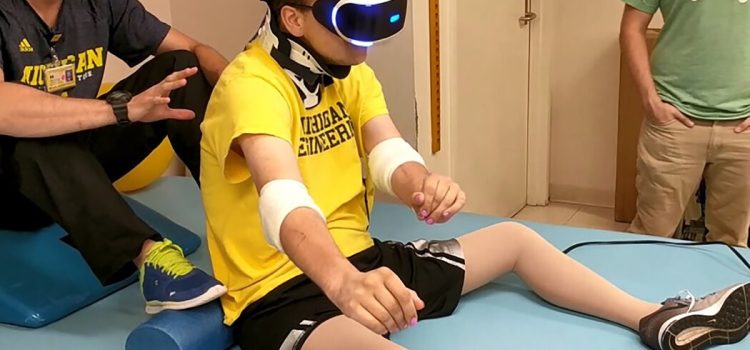
In recent years, the intersection of technology and healthcare has led to remarkable advancements in patient care and treatment methodologies. Among these innovations, Virtual Reality (VR) has emerged as a transformative tool, particularly in the field of physical rehabilitation. By creating immersive environments that engage patients in their recovery process, VR is redefining traditional rehabilitation practices and offering new hope to individuals seeking to regain physical function and mobility.
The Rise of Virtual Reality in Healthcare
Virtual Reality, once primarily associated with gaming and entertainment, has found a significant foothold in healthcare. Its ability to simulate real-world environments and scenarios makes it an ideal medium for therapeutic interventions. In physical rehabilitation, VR is used to design interactive exercises that promote motor skills, balance, coordination, and strength, all while providing an engaging and motivating experience for patients.
How Virtual Reality Enhances Physical Rehabilitation
Customized Therapy Sessions:
One of the most significant benefits of VR in physical rehabilitation is its ability to tailor therapy sessions to the specific needs of each patient. By adjusting the difficulty level and type of exercises, therapists can create personalized rehabilitation programs that address individual goals and challenges. This customization ensures that patients receive the most effective treatment possible, which can lead to quicker and more sustainable recovery outcomes.
Increased Patient Engagement:
Traditional rehabilitation exercises can often be monotonous and repetitive, leading to decreased patient motivation and adherence. VR, on the other hand, transforms these exercises into engaging and interactive experiences. Patients can find themselves immersed in virtual environments where they might be tasked with navigating obstacle courses, playing sports, or even exploring new worlds—all while performing therapeutic movements. This gamification of therapy not only makes the process more enjoyable but also encourages patients to participate more fully and consistently in their rehabilitation.
Real-Time Feedback and Progress Tracking:
VR systems are equipped with sensors and tracking devices that provide real-time feedback on a patient’s performance. This immediate feedback allows patients to adjust their movements and techniques on the spot, promoting more effective learning and improvement. Additionally, VR systems can track progress over time, offering valuable data that therapists can use to refine treatment plans and set achievable goals.
Safe and Controlled Environment:
For many patients, especially those recovering from severe injuries or surgeries, safety is a paramount concern. VR provides a controlled environment where patients can practice movements and exercises without the risk of falling or further injury. This safety net allows patients to push their limits and gain confidence in their abilities, which is crucial for successful rehabilitation.
Remote Rehabilitation Possibilities:
The COVID-19 pandemic highlighted the need for remote healthcare solutions, and VR has proven to be a valuable tool in this regard. With VR systems, patients can participate in rehabilitation sessions from the comfort of their own homes. This accessibility is particularly beneficial for individuals who live in remote areas or have mobility issues that make traveling to a clinic challenging.

Applications of Virtual Reality in Physical Rehabilitation
The versatility of VR technology allows it to be applied across a wide range of rehabilitation scenarios. Some notable applications include:
Neurological Rehabilitation:
For patients recovering from strokes, traumatic brain injuries, or neurological disorders, VR can aid in retraining the brain to control movements. Virtual exercises can help improve motor function, coordination, and cognitive abilities by stimulating neural pathways and encouraging neuroplasticity.
Orthopedic Rehabilitation:
Individuals recovering from fractures, joint replacements, or orthopedic surgeries can benefit from VR’s ability to simulate weight-bearing and range-of-motion exercises. These simulations help restore strength and flexibility while reducing the risk of re-injury.
Balance and Gait Training:
VR is particularly effective in improving balance and gait, which are crucial for preventing falls and enhancing mobility. Patients can practice walking on different surfaces, navigating obstacles, and maintaining balance in challenging scenarios, all within a safe virtual environment.
Challenges and Considerations
While the benefits of VR in physical rehabilitation are substantial, there are challenges and considerations that must be addressed. One primary concern is the cost of VR systems and the need for specialized equipment, which can be a barrier for some healthcare facilities and patients. Additionally, there is a learning curve associated with using VR technology, both for therapists and patients, which may require additional training and support.
Furthermore, ensuring the accuracy and reliability of VR systems is crucial to avoid any negative impacts on patient outcomes. Ongoing research and development are necessary to refine these technologies and ensure they meet the rigorous standards required in healthcare settings.
The Future of Virtual Reality in Rehabilitation
As VR technology continues to evolve, its role in physical rehabilitation is expected to expand and become more sophisticated. Advances in artificial intelligence and machine learning may lead to even more personalized and adaptive rehabilitation programs. Moreover, as VR becomes more accessible and affordable, it is likely to become a standard component of rehabilitation protocols worldwide.
In conclusion, Virtual Reality is revolutionizing the field of physical rehabilitation by offering innovative, engaging, and effective treatment options for patients. By enhancing patient engagement, providing real-time feedback, and creating safe environments for recovery, VR has the potential to improve outcomes and quality of life for countless individuals. As technology continues to advance, the integration of VR in rehabilitation practices promises to unlock new possibilities in patient care and recovery.








